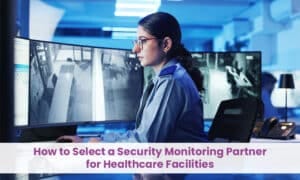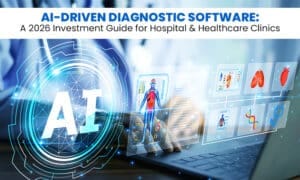
Hospitals and clinics across the globe face a mounting challenge—doctors spend far too much time on administrative work instead of patient care. Research shows that physicians in many facilities dedicate nearly half their day to documentation, billing, and records management. This imbalance directly impacts patient experience, clinical outcomes, and staff morale.
The answer lies in hospital software for doctors—solutions that reduce hospital admin workload, streamline operations, and create more space for high-quality patient care. When paired with AI capabilities, modern HIMS platforms provide measurable healthcare automation benefits, enabling medical teams to deliver faster, more personalised services while preventing HIMS and doctor burnout.
The Administrative Burden Doctors Face Today
Doctors are often caught between their passion for treating patients and the endless paperwork that comes with hospital operations. From patient history entries and compliance documentation to billing coordination and insurance claims, administrative duties consume hours each day. Without medical staff efficiency tools, these tasks create bottlenecks, slow decision-making, and limit the time doctors can spend on patient engagement.
For hospitals aiming to grow, these inefficiencies aren’t just a nuisance—they erode competitiveness. Patients expect speed, accuracy, and attention. Without systems that reduce hospital admin workload, the gap between patient expectations and service delivery widens.

Burnout: The Hidden Cost of Admin Overload
Excessive administrative pressure leads to HIMS and doctor burnout—a problem that costs hospitals in turnover, recruitment expenses, and declining quality of care. Burnout diminishes focus, increases stress-related absenteeism, and lowers patient trust. By integrating hospital software, organisations can reclaim valuable time for patient care while protecting staff from long-term exhaustion.
How HIMS Reduces Administrative Workload
Modern hospital software for doctors is transforming the way healthcare teams manage day-to-day operations. Instead of struggling with fragmented paper files or outdated legacy systems, hospitals can now rely on a secure, centralised platform that stores all patient information in one place.
This integrated system allows physicians and nurses to instantly access lab test results, treatment histories, prescriptions, and consultation notes without wasting time searching through files. By streamlining access to information, HIMS significantly helps reduce hospital admin workload while improving service speed and accuracy.
One of the most valuable healthcare automation benefits is the elimination of repetitive data entry. When patient records automatically update across all connected systems, there is no need to re-enter the same information multiple times. This prevents delays, reduces human error, and ensures that no critical details are lost in communication between departments. As a result, doctors spend more time with patients and less time managing paperwork.
• Automated Billing and Insurance Processes
Financial paperwork is one of the most time-consuming and frustrating parts of hospital administration. Revenue leakage often occurs when claims are delayed, incorrectly processed, or denied due to missing documentation. HIMS tackles this problem by automating the entire billing and insurance workflow. It validates insurance eligibility in real time, processes claims faster, and sends automated payment reminders to patients.
These tools not only prevent backlogs and disputes but also free medical teams from unnecessary administrative pressure. By removing the need for doctors to get involved in billing corrections or claim follow-ups, medical staff efficiency tools create more time for patient care. Hospitals benefit from faster revenue cycles, while doctors experience less burnout caused by administrative overload—showing the direct connection between HIMS and doctor burnout reduction.
• Streamlined Appointment Scheduling & Follow-ups
Appointment scheduling can consume a large portion of hospital staff time, especially when done manually. Traditional methods often lead to gaps in doctor availability, missed appointments, and inefficient patient flow. HIMS solves this by using AI-powered scheduling features that match patient needs with the most suitable physician time slots.
Automated reminders sent via SMS, email, or app notifications ensure patients show up on time, reducing last-minute cancellations. The same system manages follow-up appointments, ensuring continuity of care without extra manual effort from staff. When hospitals use hospital software for doctors with built-in scheduling automation, they can reduce the workload of hospital admins, improve operational efficiency, and provide a smoother patient experience.
These automation-driven improvements represent some of the most impactful healthcare automation benefits, ensuring that both medical staff and patients benefit from a more organised, efficient, and stress-free hospital environment.

Fighting Burnout with AI-Driven HIMS Solutions
• Real-Time Data and Decision Support
AI-enabled hospital software offers real-time decision support by integrating lab results, imaging data, and medical history into a single dashboard. This reduces time spent searching for information and speeds up diagnosis. Such efficiency not only delivers measurable benefits in terms of healthcare automation but also prevents the overload that leads to HIMS and doctor burnout.
• Task Automation for Routine Clinical Work
Hospitals can now automate prescription refills, lab orders, and discharge summaries through advanced medical staff efficiency tools. This dramatically reduces hospital admin workload, freeing clinicians to handle more complex cases and consult more patients per day. Automation also standardises these tasks, ensuring consistency and accuracy.
• Improved Work-Life Balance
The fastest way to prevent HIMS and doctor burnout is by creating schedules that allow doctors to recharge. By removing repetitive tasks and minimising after-hours paperwork, hospital software for doctors restores balance. This leads to happier staff, improved retention, and better patient interactions—clear healthcare automation benefits for the organisation.
HIMS as a Catalyst for Better Patient Care
In modern healthcare, time is the most valuable resource for doctors and nurses. Every minute saved through medical staff efficiency tools becomes a minute doctors can dedicate to meaningful patient interaction. This extra time allows them to answer more questions, explain diagnoses in greater depth, and build stronger relationships with their patients.
Hospitals that proactively work to reduce hospital admin workload consistently see their patient satisfaction scores rise. The connection is simple—when clinicians spend less time buried in paperwork and more time with patients, care becomes more attentive, personalised, and impactful.
Impact of HIMS on Administrative Efficiency and Patient Care Quality
| Hospital Type | Avg. Admin Hours Saved per Week (per doctor) | Increase in Patient Interaction Time (%) | Improvement in Patient Satisfaction Scores (%) | Reduction in Billing/Claim Errors (%) |
| Small Clinic | 5 | 12 | 8 | 10 |
| Mid-sized Hospital | 8 | 18 | 14 | 15 |
| Large Multi-specialty Hospital | 12 | 25 | 20 | 22 |
| Tertiary Care Center | 15 | 30 | 24 | 28 |
The data below illustrates how implementing Hospital Information Management Systems (HIMS) impacts various hospital types. By reducing administrative workload, HIMS frees up valuable time for doctors to engage more with patients. Small clinics save around 5 hours per doctor weekly, while tertiary care centres save up to 15 hours. This extra time leads to increased patient interaction, improved satisfaction scores, and fewer billing errors. The correlation is clear: the greater the efficiency gains, the more personalised and accurate the patient care becomes, ultimately enhancing the hospital’s reputation and patient trust.
Faster Diagnosis and Treatment
One of the strongest advantages of implementing hospital software for doctors is its ability to integrate all patient data into a single, intuitive interface. When a physician can instantly access lab results, medical histories, and imaging reports without switching between multiple systems, diagnostic speed improves dramatically. This benefit is especially critical for emergency and high-risk cases, where even small delays can have serious consequences.
By streamlining data access, hospitals remove the inefficiencies caused by scattered records, ensuring faster decisions and earlier interventions. These are clear healthcare automation benefits that not only shorten wait times and accelerate recovery but also enhance patient safety—factors that directly strengthen a hospital’s reputation.
Improved Patient Outcomes and Satisfaction
Hospitals that leverage HIMS and other medical staff efficiency tools designed to reduce hospital admin workload report measurable improvements in clinical outcomes. When administrative barriers are minimised, healthcare providers can focus fully on diagnosis, treatment, and patient engagement. Patients notice this shift—they appreciate the efficiency, the transparency of their treatment journey, and the reduced delays in receiving care.
Pairing HIMS with AI-driven analytics further amplifies these advantages. Predictive insights help doctors make informed decisions faster, detect potential complications earlier, and tailor treatment plans more precisely. These capabilities reflect the broader healthcare automation benefits that keep patients satisfied while also driving long-term loyalty. By integrating hospital software for doctors into daily operations, hospitals not only meet patient expectations but consistently exceed them, creating a strong competitive edge in the healthcare industry.
Why AI-Based HIMS is the Future of Healthcare
• Predictive Analytics for Proactive Care
AI-powered hospital software for doctors can anticipate patient risks before symptoms worsen. These predictive models are one of the strongest healthcare automation benefits, helping clinicians prevent emergencies and improve long-term health outcomes. For hospitals, this means fewer crisis cases and better resource allocation.
• Smart Resource Management
From managing operating theatre schedules to optimising staffing levels, medical staff efficiency tools ensure resources are available when needed. These tools reduce hospital admin workload in planning, minimise waste, and help administrators track usage patterns for continuous improvement.
• Enhancing Hospital Reputation and Competitiveness
Modern hospitals compete not only on care quality but also on operational excellence. Adopting hospital software that integrates automation positions a facility as forward-thinking, efficient, and patient-focused. Preventing HIMS and doctor burnout while improving outcomes builds trust with both patients and medical professionals.
Choosing the Right HIMS for Your Hospital or Clinic
When selecting hospital software, ensure it offers:
- Scalability to grow with the hospital
- Interoperability with existing systems
- Strong data security protocols
- AI capabilities for predictive and automated workflows
The Importance of Reliable Vendor Support
Hospitals need vendors who provide continuous updates, staff training, and responsive assistance. Ongoing support ensures systems remain efficient, prevent downtime, and avoid HIMS and doctor burnout caused by operational interruptions.
Measuring Success After Implementation
Administrators should measure reductions in documentation time, increases in patient throughput, and higher satisfaction scores. These metrics confirm that medical staff efficiency tools are delivering the expected ROI and genuinely reduce hospital admin workload.
A Day in the Life of a Doctor, Reimagined
In the fast-paced healthcare industry, every second counts. AI-powered hospital software for doctors transforms clinical workflows, allowing hospitals to reduce hospital admin workload, enhance patient satisfaction, and prevent HIMS and doctor burnout. The healthcare automation benefits extend beyond the doctors—administrators gain operational control, patients receive timely care, and hospitals strengthen their market position.
The message for healthcare leaders is clear: invest in medical staff efficiency tools today to ensure a future where doctors spend more time healing patients and less time filling out forms. Efficiency, quality care, and reputation go hand in hand—and HIMS is the bridge that connects them.





